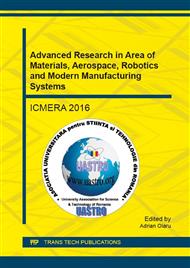[1]
L. ab Su, Y. a Qi, L. -L. b Jin, G. -L. b Zhang, Integrated batch planning optimization based on fuzzy genetic and constraint satisfaction for steel production, Int. J. of Simulation Modelling 15 (1) (2016) 133-143.
DOI: 10.2507/ijsimm15(1)co1
Google Scholar
[2]
G.E. Totten, Steel Heat Treatment Handbook: Metallurgy and technologies, CRC Taylor & Francis Group, (2006).
Google Scholar
[3]
V. Geantă, R. Ştefănoiu, Ingineria producerii oţelului (Steel production engineering), Ed. Bren, Bucureşti, Romania, (2008).
Google Scholar
[4]
J. Campbell, Castings. Second ed., Butterworth-Heinemann Press, (2003).
Google Scholar
[5]
J. Lin, M. Liu, J. Hao, S. Jiang, A multi-objective optimization approach for integrated production planning under interval uncertainties in the steel industry, Computers and Operations Research 72 (2016) 189-203.
DOI: 10.1016/j.cor.2016.03.002
Google Scholar
[6]
Q.K. Pan, An effective co-evolutionary artificial bee colony algorithm for steelmaking-continuous casting scheduling, Eur. J. of Operational Research 250 (3) (2016) 702–714.
DOI: 10.1016/j.ejor.2015.10.007
Google Scholar
[7]
K. Kusakana, Energy dispatching of an isolated diesel-battery hybrid power system, Proc. of the IEEE Int. Conf. on Industrial Technology, 19 May 2016, 499-504.
DOI: 10.1109/icit.2016.7474801
Google Scholar
[8]
N. Karimi, H. Davoudpour, A knowledge-based approach for multi-factory production systems, Computers and Operations Research 77 (January 2017) 72-85.
DOI: 10.1016/j.cor.2016.07.003
Google Scholar
[9]
Robert J. Vanderbei, Linear Programming: Foundations and Extensions, Third ed., Springer US, (2008).
Google Scholar
[10]
Information on https: /www. math. ucla. edu/~tom/LP. pdf.
Google Scholar
[11]
L.P. Garces, L.A. Gallego, R. Romero, Bounded Dual Simplex Algorithm: Definition and Structure, in: I. Zelinka, V. Snášel, A. Abraham (Eds. ), Handbook of Optimization. From Classical to Modern Approach, Springer, 2013, pp.29-31.
Google Scholar
[12]
Optimization ToolboxTM 4. User's guide, The MathWorks, Inc., 1990 – (2008).
Google Scholar
[13]
K. Kusakana, Optimal scheduled power flow for distributed photovoltaic/wind/diesel generators with battery storage system, IET Renewable Power Generation 9 (8) (2015) 916 – 924.
DOI: 10.1049/iet-rpg.2015.0027
Google Scholar


